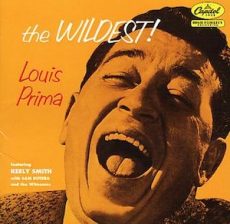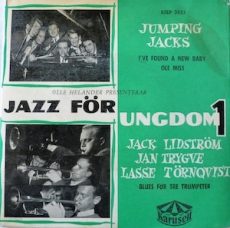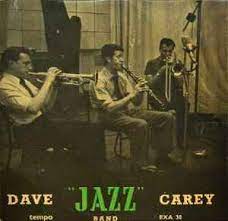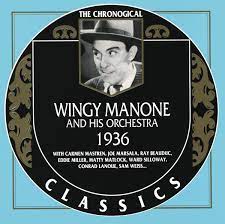
Daily Dose Of Jazz…
Louis Leo Prima was born December 7, 1910 in New Orleans, Louisiana into a musical Italian American family. His mother, a music lover, made sure that each child played an instrument, assigning him the violin and started out playing at St. Ann’s Parish. His interest in jazz came when he heard black musicians, including Louis Armstrong at a time Italians and Blacks in New Orleans frequently socialized together in the same clubs and bars.
He practiced continuously on his worn-down cornet and formed a band in 1924 with his childhood friends, bassist Candy Candido, Irving Fazola on clarinet and drummer Johnny Viviano. Prima attended Jesuit High School but transferred to Warren Easton High in 1926. There he played with the Eastonites, the school band. The next year he partnered with fellow musician Frank Federico and they played in the French Quarter.
By 1928 his decision was made to become a professional musician. After finishing high school he joined the Ellis Stratako Orchestra in 1929 then the Joseph Cherniavsky Orchestrafollowed by a temporary job playing on the steamship Capital that docked on Canal Street. His first break was when Lou Forbes hired him for daily afternoon and early evening shows at The Saenger.
1934 saw him begin recording for the Brunswick label. He recorded That’s Where the South Begins, Long About Midnight, Jamaica Shout, and StarDust. Prima and his New Orleans Gang featured Frank Pinero playing piano, Jack Ryan bass, Garrett McAdams guitar, and Pee Wee Russell clarinet. at the Famous Door. HIs recordings from 1935 were a combination of Dixieland and swing. He and Russell recorded The Lady in Red, a national jukebox hit. They also recorded Chinatown, Chasing Shadows and Gypsy Tea Room.
Martha Raye played a role in Prima’s professional and personal life and with her got his first national debut on The Fleischman Hour. He recorded Sing, Sing , Sing in 1936, which subsequently became a hit for Benny Goodman. Moving to California he expanded his music, joining the movement for big bands and orchestras. However for him the configuration was not successful.
He returned to New York City in 1937 with his quintet at the Famous Door. Then on to Billy Rose’s Casa Mañana club in 1938, earning nearly a quarter million dollars throughout seven weeks. This led to an East Coast to mid-West tour. During the war years, Louis was experiencing great success regardless of anti-Italian sentiment. He would go on to have several big hits but by the end of the war years, the popularity of big band music was diminishing. By 1947 he was playing more jazzy versions of his music for the next decade and a half.
Trumpeter, singer, entertainer and bandleader Louis Prima suffered a heart attack in 1973. Two years later he was diagnosed with a brain stem tumor, suffered a cerebral hemorrhage, went into a coma following surgery and never recovered. He moved back to New Orleans and transitioned three years later on August 24, 1978 at 67 in his hometown.
More Posts: bandleader,history,instrumental,jazz,music,trumpet

Daily Dose Of Jazz…
Lasse Törnqvist was born Lars Törnqvist on November 18, 1935 in Bromma, outside Stockholm, Sweden. Between 1952 and 1957 he played traditional jazz with the Midnight Stompers. He took a music hiatus but picked up playing again in 1973 in more swing and mainstream influenced sextest and septets, like the Olle Orrjes Jazz Band and Lasse Törnqvist’s Blue Stars.
He experimented with small bands in order to achieve a more acoustic sound. During the 1980s he often played with a cornet and piano duo. In 1992 he put a trio together with guitar and bass which became the Sweet Jazz Trio.
Cornetist Lasse Törnqvist, at 98 years old, no longer plays.More Posts: bandleader,cornet,history,instrumental,jazz,music

Daily Dose Of Jazz…
David Arthur Carey was born November 8, 1914 in Coulsdon, Surrey, England. His father was a pianist. In the early Thirties he had his own band that performed in the Croydon borough of London. After the start of World War II he opened a music shop in Streatham before being drafted into military service. In 1946 he opened The Swing Shop in Streatham, where he sold musical instruments and records and which he expanded into a mail order business.
He also played in dance and jazz bands in 1947 with Rex Stewart, who was visiting England, with whom he also recorded in London in September 1949, and in 1948 with Graeme Bell’s Australian Jazz Band. In the same year, Carey took part in recordings by Humphrey Lyttelton for Wilco, in 1950 with the boogie-woogie pianist Roy Vaughan. He was in Lyttleton’s band for a year in 1948 until he was replaced by Bernard Saward. The mid-1950s Dave led his own traditional jazz formations and recorded a number of records for Tempo Records and Decca Records.
Carey performed at the Royal Festival Hall in 1957 and contributed to pianist Pat Hawes’ recordings for Tempo. He worked as a music historian, collaborating with Albert McCarthy and the six-volume work Jazz Directory spanning 1949 to 1952. In the Sixties he led his own band in the 1960s.
According to his colleague Pat Hawes, his drumming was influenced by Baby Dodds, but also by drummers of the swing era such as Gene Krupa, Cozy Cole and George Wettling.
Drummer, bandleader and jazz researcher Dave Carey, who also plays vibraphone and washboard, transitioned on July 18 , 1999 in Croydon.
More Posts: bandleader,drums,history,instrumental,jazz,music,researcher,vibraphone

Daily Dose Of Jazz…
Conrad Lanoue was born on October 18, 1908 in Cohoes, New York. He started on piano when he was ten years old and attended the Troy Conservatory.
Beginning his career in his 20s, he played piano at hotels in his hometown. Conrad recorded with Red McKenzie in 1935, and under the combined leadership of trumpeter Eddie Farley and trombonist Mike Riley in 1935–36. During the 1930s he worked for Louis Prima, then Wingy Manone from 1936 to 1940 followed by playing with pianist Joe Haymes.
From the 1940s to the 1960s, he was a member of bands led by Lester Lanin, Charles Peterson, and Hal Landsberry. He also wrote big band arrangements. Pianist and arranger Conrad Lanoue, who never recorded as a leader, retired in 1968 due to illness and transitioned in Albany, New York on October 15, 1972.

Daily Dose Of Jazz…
George Horace Webb was born on October 8, 1917 in London, United Kingdom to a former music hall artiste. He grew up with a love of early jazz recordings, principally those made by the New Orleans musicians. A keen jazz enthusiast, he was a self-taught amateur pianist.
Working as a machine gun fitter in the Vickers-Armstrong factory at Crayford, he organized lunchtime entertainment at the factory, assembling scratch bands from among the workers. With his band, George Webb’s Dixielanders, he played regularly and famously at The Red Barn public house at Barnehurst, Kent, beginning in the early 1940s. They made several recordings and BBC radio broadcasts but by 1948 they had disbanded.
Webb was then part of Humphrey Lyttelton’s band from 1948 to 1951. After a short-term reformation of the Dixielanders in 1952, he concentrated on running a jazz club. In the mid-Sixties he was a musician agent and manager. Early in the following decade, he returned to more frequent playing and toured Europe as a soloist. Another version of the Dixielanders operated for a year and then ran a pub for 12 years.
A move back to Kent had him guest performing in various bands into the 2000s with Humphrey Lyttelton, Wally Fawkes and Eddie Harvey. In his playing he tried to re-create the style of such bands as King Oliver’s.
Pianist George Webb, who is considered by many as the father of the traditional jazz movement in Britain, transitioned on March 10, 2010.
More Posts: bandleader,history,instrumental,jazz,music,piano




